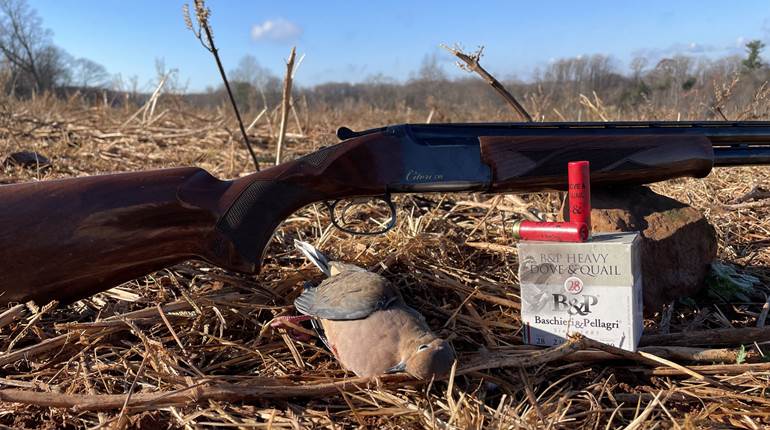
The 7.62x39 mm shooter should consider handloading to ensure a steady supply of accurate, high-performance loads and to achieve shot-to-shot consistency. Best results can be expected when bullets are selected that properly match the bore dimensions.
The unassuming 7.62x39 mm (M43) cartridge is likely more popular today than ever. Technological advancements in components and the introduction of high-quality firearms chambered for the cartridge during the past few years alone have renewed interest in the Soviet stalwart. As such, it’s prudent to revisit it.
Origins
Often reported as being the impetus for the development of the 7.62x39 mm (M43) cartridge, the Battle of Cholm, or Cholm Pocket—which took place on the Eastern Front from Jan. 23, 1942, to May 5, 1942—saw the fielding of a new cartridge, the 7.92x33 mm Kurz, by the German military. Also known as the 7.92 Kurz, it demonstrated the effectiveness of a new concept: a battle cartridge of intermediate range and power. Although less powerful than the German 7.92x57 mm Mauser rifle cartridge, it offered superior external and terminal ballistics to those of the 9 mm Luger pistol and submachine gun cartridge. Effective at typical combat engagement distances (out to 300 meters), the mild-mannered 7.92 Kurz permitted controllable (and thus accurate) full-automatic firing at a high-cyclic rate. The Russians took note.
Development of the Russian’s own intermediate-range cartridge began in earnest during July 1943, and seven months later it was adopted. But it wasn’t the 7.62x39 mm that emerged; instead, the resulting cartridge had a 41 mm case. Not until after a further round of refinements did the now-familiar 7.62x39 mm (M43) debut.

The 7.62x39 mm’s intended use is apparent in its design. Destined to be utilized in a host of infantry arms—ranging from semi-automatic carbines and select-fire rifles to light machine guns—it was first chambered in the Ruchnoy Pulemyot Degtyaryova (RPD) followed by the Samozaryadnyj Karbin sistemy Simonova, 1945 (SKS-45). It later achieved worldwide fame in the Avtomat Kalashnikova (AK-47). Each platform demanded that the rimless, bottleneck case have a shallow shoulder angle and generous taper for reliable feeding and extraction—especially in full-automatic operation. According to the Hornady Handbook of Cartridge Reloading, 9th Edition, the shoulder angle is 17°, 30', the same as the venerable .30-’06 Sprg., and the case tapers from 0.443" forward of the extraction groove to 0.396" at the shoulder. The 0.047" decrease in width along its body is why magazines for guns chambered for the cartridge, such as the SKS and AK-47, are curved.

Concerning the case head diameter, whereas Hornady’s manual lists it as 0.447", the Sierra Reloading Manual, 5th Edition, has it listed as 0.445"—a somewhat unique dimension. Case capacity is reported to be around 35 grs. of water—nearly identical to that of the .30-30 Win. The Sporting Arms and Ammunition Manufacturers’ Institute (SAAMI) set the maximum average pressure (MAP) at 45,000 p.s.i., while that for Commission Internationale Permanente Pour L’epreuve Des Armes A Feu Portatives (CIP) is higher.
Similar to the 7.62x54 mm R, the full-power cartridge utilized by the Red Army, the groove diameter of 7.62x39 mm-chambered arms varies slightly; whereas 0.310" to 0.312" are encountered, the typical diameter is 0.311" (7.92 mm). Since its debut, and until as recently as the 2000s, Russian engineers have continually updated the cartridge’s projectiles, changing bullet profiles, core composition and heat-treating—even bullet diameter for a subsonic load. According to Speer Bullet’s Reloading Manual No. 14, the military full-metal-jacket bullet is 0.3095" and, due to its hollow base, obturates to seal the bore.
 Performance
Performance
Despite its smallish space for propellant, 1.528" maximum case length and a maximum cartridge overall length of 2.200", the 7.62x39 mm handily fulfills the role for which it was created—intermediate-range target engagement. For instance, with a 200-yd. zero, Hornady’s 123-gr. SST, which has a ballistic coefficient of 0.295, drops 14.80" at 300 yds., but at 400 yds. it drops 45.20" (when propelled to 2350 f.p.s.). As you can see, shooting much beyond 300 yds. is impractical. Another way of thinking about it, the cartridge virtually replicates the performance of the newer .300 Blackout.
Outside of special subsonic loads featuring 12.5-gram (192.9-gr.) bullets developed during the 1950s, most military-type loads utilize 122- to 124-gr. bullets propelled to muzzle velocities around 2400 f.p.s, producing energy levels of about 1,550 to 1,600 ft.-lbs. of energy—again, consider its intended purpose and range. Also available, though lesser in number, are those weighing 120 grs., 125 grs. and 154 grs.—the latter being the heaviest practical weight. Due to pressure ceiling differences, the variations in American and European and/or Asian 7.62x39 mm ammunition is readily apparent on the chronograph screen and on the shoulder. In general, the latter is around 100 to 200 f.p.s. faster than the former. In real-world applications, such as hunting, there’s no practical difference.
Commonly compared to the .30-30 Win., the 7.62x39 mm’s velocity with 123-gr. bullets is similar to what the Winchester attains with 150-gr. projectiles. When loaded with 150- to 154-gr. bullets, the Russian’s muzzle velocity is about 300 f.p.s. less than the classic whitetail round, but at 300 yds. the drop is virtually identical due to the better BC of the Russian cartridge’s spitzer-profile bullets. But, the .30-30 Win. has the ability to handle heavier 170-gr. bullets, too, giving it an edge. Again, the 7.62x39 mm is also similar in performance to the .300 Blackout, but the latter has the ability to use heavier bullets at both subsonic and supersonic velocities.

Loading The 7.62x39 mm
Handloading for the 7.62x39 mm is anything but straightforward; much forethought is required before lowering the press handle for the first time. First, most reloading die sets come with two expander balls (one for use with 0.308"-diameter bullets, the other being 0.311") due to the fact that most, but not all, 7.62x39 mm-chambered rifles—especially surplus military guns—have bore diameters of 0.311" to 0.312". Some rifles, though, have bores for use with 0.308"-diameter bullets. It’s prudent to accurately determine your rifle bore’s groove-to-groove diameter before setting up the resizing die and purchasing bullets. Shooting oversized bullets can affect pressure, while undersized bullets could negatively affect accuracy. Inevitably, the question comes up, “Can it be done?” As Sierra Bullets reported in its reloading manual, “As a point of interest, we tried using .311" diameter bullets in our 0.308"-diameter-bore Ruger test rifle, as well as .308" diameter bullets in a 0.312"-diameter-bore Russian SKS. Although hardly an ideal situation, both combinations performed surprising well.” Still, I’d personally select the one that fits your bore diameter.
As with factory ammunition, 0.310" to 0.311"-diameter bullets aren’t offered in as impressive an array of designs as are 0.308" bullets, though there’s more than enough to discourage experimenting with undersized bullets. Despite being able to handle bullets in the 150-gr. class, one has to be careful when hunting with them to ensure that sufficient velocity at the intended range remains to facilitate reliable expansion. I suggest sticking with bullets in the 120- to 125-gr. range that were designed to perform at the 7.62x39 mm’s modest velocities; remember the cartridge’s limited propellant capacity. Some of the best hunting bullets available as components in this weight range are: Hornady 123-gr. V-Max, Z-Max, Spire Point and SST; Speer Hot-Cor 123-gr. SP; Sierra 125-gr. Pro-Hunter; Barnes 123-gr. TAC-X and TSX; Winchester 123-gr. Power-Point; and Remington 125-gr. SP. The V-Max or Z-Max (the same except for tip color) should only be used on varmints and small predators (if hide preservation isn’t a goal) because of their light construction, while all others listed are suitable for everything from feral hogs to whitetail deer. They’ll put down a black bear in a pinch, too. Lead-free, controlled-expansion bullets in this diameter are only available from Barnes at this point, but hopefully that will change in the future.
Heavier bullets in the same diameters are available from many of the same companies, too. Yes, the ballistic coefficients of bullets in this diameter are unimpressive, but remember its intended purpose—intermediate range. High-quality match projectiles are available from Lapua, and FMJs from nigh all manufacturers, and Barnes has a 108-gr. lead-free frangible bullet, too.

Should your 7.62x39 mm rifle have a bore designed for .308"-diameter bullets, the best terminal performance will likely come from those projectiles that were designed specifically for the .300 Blackout. Again, select lighter weight bullets from 110 to 130 grs. that can be propelled to higher velocities so that expansion can be ensured. Good choices in this weight range are abundant. Ballistic coefficients will be better than those of the 0.310" to 0.311"-diameter bullets, but still nothing to write home about. All bullets with cannelures or grooves should be crimped.
Although it was once somewhat difficult to locate new brass, this is becoming less problematic. The short list of companies producing component brass includes: Hornady, Winchester, Privi Partizan and Lapua. Although the most costly, Lapua brass allows for far more loading cycles than all others. In fact, all load data assembled for this article was accomplished with one, 100-count box of Lapua brass. Yeah, it’s worth the money. Another option is to reload once-fired brass from manufacturers of Boxer-primed cases such as Federal, Remington, Sellior & Bellot and Fiocchi. Do not reload steel cases; instead, discard (or recycle) Berdan-primed cases, and segregate cases (small and large rifle primers).
Primers are of the utmost importance when loading 7.62x39 mm ammunition. According to the above-mentioned Speer manual, “Many variants of the SKS lack a firing pin retractor spring. These may inadvertently slam-fire (the cartridge fires as the bolt closes but before the bolt fully locks).” The problem is compounded with improper (due to wear) headspacing and guns that are dirty and/or caked with solidified grease or preservatives, which can cause the firing pin to stick. (For a mechanical solution, check out murraysguns.com.) This is because of the sensitivity of commercial primers. No such problems should be encountered with new-production and modern arms. For those individuals loading for SKSs (especially) and other military rifles, CCI has No. 34 Arsenal large rifle primers, which have mil-spec sensitivity. But it’s recommended that loads be reduced by one grain if these primers are used. Regardless of the primer used, they must be seated 0.003" to 0.005" below flush.

As for propellants, top choices for 123-gr. bullets are: Vinhtavuori N-120; IMR-4198; Hodgdon H4198 and Benchmark; Ramshot X-Terminator; Accurate-5744, 2015, 1680, and LT-30 and 32; and Alliant Reloder 7. Vihtavuori N-130 and Accurate-2200 provide top velocities with 150-gr. bullets. Of those, my personal favorites are Vihtavuori N-120, Hodgdon Benchmark Accurate-1680, 2200, 5744 and LT-30.
As you’ll see in the accompanying table, shooters stand to gain little in terms of velocity from handloading; in fact, even equaling velocities of foreign-made ammunition is a journey frought with frustration. Also, one doesn’t reload to save money over inexpensive, Russian-made steel-case ammunition; it cannot be done. The handloader loads for the 7.62x39 mm for two reasons: First, premium-quality, accurate ammunition is inconsistently available at best, and certainly nearly impossible to find during times of ammunition shortage. Secondly, reloading allows for shot-to-shot consistency, which brings out the best of all guns—especially well-made models. The accompanying table illustrates this very well.
While owners of 7.62x39 mm-chambered rifles stand to gain performance through handloading, military arms with looser dimensional tolerances are not likely to produce results as good as those obtainable from high-quality commercial arms such as the Rock River LAR-47 X1 (used for load development here), CMMG Mutant, Ruger Mini-30 and CZ 527 Carbine.
Keep in mind, though, that the key to unlocking the 7.62x39 mm’s utmost potential is matching its projectiles to the bore diameter of the rifle in which they will be fired.






































